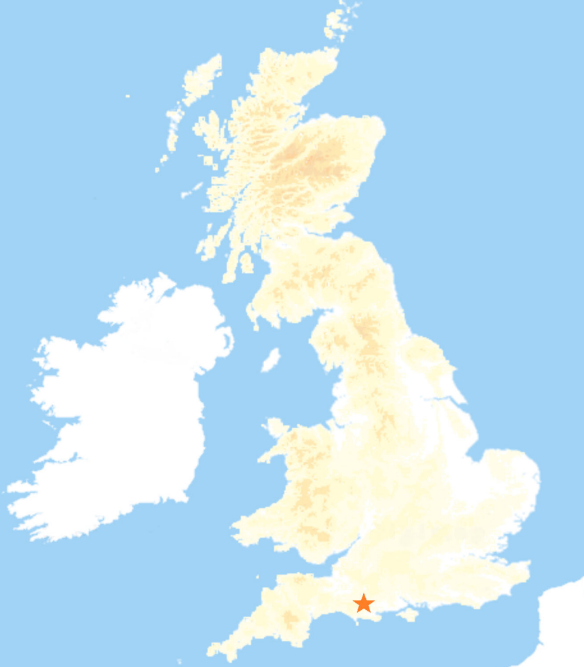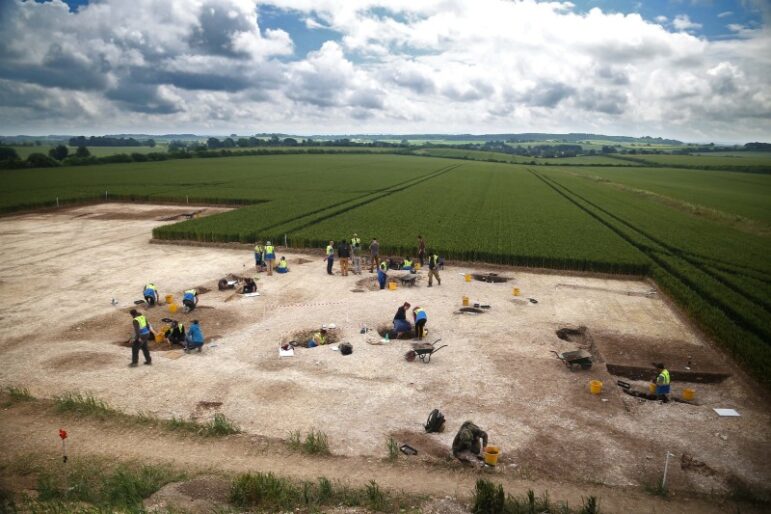Editorial Note: This article mentions ritual murder. Although the practice occurred thousands of years ago, we declined to show images of the burials and evidence of the violence. Those interested in more information are welcome to use the link to the scientific publication describing the practices.
LONDON – The stories connecting ancient practices to human sacrifice surface constantly. Although the practice is referenced as part of the British Iron Age society by both ancient and modern authors, physical evidence of the practice in the archaeological record remains relatively rare. New research points to more conclusive and disturbing evidence.
The narrative is complex, and new research highlights the violence against women and class struggles, adding further layers to the complexity of ancient beliefs.
Earlier this year, the Antiquaries Journal published an article by archeologist Miles Russell and his colleagues at Bournemouth University. Archaeologists had discovered an adult skeleton that had met a violent death, found in a burial pit in southern England, located in what is now the town of Winterbourne Kingston, in Dorset County.
Ritual priests had arranged the skeleton face down on a platform of animal bones. While reports of human sacrifice among the Iron Age British Celts exist, definitive evidence for it has remained elusive.
Russell and his colleagues never used the term “ritualized murder,” but that might be a more accurate description of what they uncovered.

Map showing the location of Winterborne Kingston, Dorset, within the UK and Ireland. via The Antiquaries Journal
Stories of powerful goddesses and warrior queens among the ancient Celts have long attracted the interest of modern Pagans. Some have interpreted these figures as evidence of female power in those cultures. One figure that stands out is Boudica, Queen of the Iceni, in present-day Norfolk, England. In 60 C.E., she led a British revolt against the Romans. However, in any society, the power of individual elite women says little about the power or status of lower-class women in that same society.
Few written records survive from ancient Celtic cultures, and those that do are mostly accounts written by their enemies. This lack of documentation has allowed both modern Pagans and secular scholars to project their own fantasies onto the ancient Celtic tribes. Such projections often assume a high degree of cultural uniformity among these tribes. However, the term “Celtic” refers to a language family, not a homogenous culture. Without evidence of uniformity, what is known about one Celtic tribe should not be generalized to others.
Material remains from these ancient cultures have survived, and evidence such as the burial pit in Dorset helps challenge these romanticized projections.
In the British Iron Age, the Durotriges tribe lived in Dorset. Unlike elites who may have chosen socially acceptable suicides or sacrifices, the Durotriges did not sacrifice a high-status individual. Instead, they killed a disfigured female manual laborer, who had experienced violence even before her death.
Blunt force had caused one of her prior injuries, which had begun to heal by the time of her death. In modern times, such injuries are often associated with domestic violence. Unfortunately, this ancient victim did not survive to tell her story.
Findings from her skeleton
Archaeologists classified the skeleton’s sex as female and estimated her age at death to be in her late 20s. She stood between 151.65 cm and 159.09 cm (roughly 5 to 5.2 feet tall). Her spine showed significant degeneration, indicating she had performed heavy labor, potentially as a slave.
The Durotriges practiced mixed burial customs. They often left grave goods to provide for the deceased in the afterlife, showing care for the dead. However, the woman’s burial pit lacked any such items. She died in front of others but without public mourners. Whether anyone mourned her privately remains unknown.
“In the other burials we have found, the deceased people appear to have been carefully positioned in the pit and treated with respect, but this poor woman hasn’t,” explained Dr Martin Smith, Associate Professor in Forensic and Biological Anthropology at Bournemouth University. “We have also previously found ceramic pots and remains of joints of meat next to human remains, which we believe are offerings for the afterlife. This was nothing like that. The young woman was found lying face down on top of a strange, deliberately constructed crescent shaped arrangement of animal bone at the bottom of a pit, so it looks like she was killed as part of an offering.”
Her skeleton showed notable asymmetry: her shinbones differed in length, and the right side of her face was lower than the left, suggesting disfigurement.
Strontium and oxygen analysis of her teeth revealed that she had grown up elsewhere, marking her as an outsider. Whether she was a migrant or a captive remains unclear.
A sharp blade to her neck caused her death—an intentional act.

Students excavating prehistoric settlements in Winterborne Kingston in Dorset [via Bournemouth University
The Burial Pit
The burial pit was found in a “banjo” enclosure at Winterborne Kingston in Dorset. These enclosures, shaped like banjos, featured a long passage leading to a circular area. Across Britain, archaeologists have found about 140 banjo enclosures, most of them in southern England, dating from around 400 B.C.E. to 50 B.C.E. While agricultural evidence exists in the surrounding area, pastoralism dominated.
The woman’s remains were found in one such pit, 1.2 meters (3.9 feet) deep. Her skeleton was arranged face down on a platform of animal bones, including those from cows, horses, sheep, goats, and a dog. The animal bones showed signs of butchery and weathering, while her remains did not.
The animals had likely been eaten before her death, and the mixing of her remains with theirs must have held symbolic meaning beyond convenience.
Alternative Narratives of the Ritual Murder.
The archaeologists offered two possible interpretations of the woman’s death. One suggests that the pit served as a refuse area, and her placement there may have been an act of ritual degradation. Another theory proposes that her blood sacrifice was intended to nourish the earth, with her blood flowing into the animal remains and the soil, feeding both physically and spiritually.
Violence and Women among Iron Age Briton
Prof. Rebecca Redfern of the University of Newcastle has studied violence against women in Iron Age Britain. In her chapter “A Bioarchaeological Analysis of Violence in Iron Age Females: A Perspective from Dorset, England,” she concluded that many Dorset women actively participated in interpersonal violence.
The burial practices of Celtic tribes varied over time and by tribe. Only in Dorset did burial customs persist continuously from 350 B.C.E. to 100 C.E., making it an ideal region to study one tribe’s burial practices. Redfern examined 113 adult skeletons from Dorset, mostly from Maiden Castle. These skeletons displayed multiple sharp-force injuries, with 54.9% identified as male and 45.1% as female—showing that violence affected both genders.
Redfern suggested that the injuries sustained by women could have resulted from inter-tribal conflict, domestic violence, or intra-tribal violence.
To date, while animal and human sacrifice has often been inferred in the British Iron Age, archaeological evidence for ritualized killing and its context has been scarce. The pit deposit at Winterborne Kingston is significant because it offers a narrative for the human sacrifice, detailing the victim’s death and final placement. For the first time, this unsettling evidence seems to provide a clear context for the dramatic, community-sanctioned nature of such events in the Iron Age.
“The burials that get the most attention tend to be those of higher status, privileged people,” Smith explained. “However, being able to humanise the story of this woman’s life has given us a valuable glimpse into the other side of Iron Age society. Behind every ancient burial we find is someone’s story waiting to be told.”
The Wild Hunt is not responsible for links to external content.
To join a conversation on this post:
Visit our The Wild Hunt subreddit! Point your favorite browser to https://www.reddit.com/r/The_Wild_Hunt_News/, then click “JOIN”. Make sure to click the bell, too, to be notified of new articles posted to our subreddit.